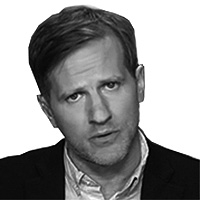In 1998, Stephen Glass’s career as a journalist began unraveling with a ripping yarn, entirely fabricated as it turned out, about the Conservative Political Action Conference (CPAC). Glass, writing in The New Republic, claimed to have followed a group of young righties—including the clichéd “meaty” Midwestern quarterback, and a “freckled boy from Iowa”—as they smoked pot, engaged in lascivious sexual behavior, and drank like an army of Hunter Thompsons in pleated pants. “This is the face of young conservatism in 1997,” he wrote. “Pissed off and pissed; dejected, depressed, drunk and dumb.”

In 2013 Glass’s story, had it been real, would have scandalized nobody. It’s rather common to find college-age attendees at CPAC offering full-throated support for either the decriminalization or legalization of marijuana (lots of sly smirks when asked, but no one would admit to smoking pot, except for some of those rock-ribbed libertarian attendees). And despite the focus on the exclusion of the gay conservative group GOProud, I had a difficult time finding young conservatives who believed gay Republicans should be excluded from the conference.
Indeed, the libertarian crowd has been increasingly vocal at Obama-era CPACs—Ron Paul has routinely won the annual straw poll—but this year, the Rand Paul Brigades look something like an occupying force. Everywhere one turns, there are “Stand With Rand” signs, stickers, and T-shirts (a volunteer told me he had handed out a thousand shirts in just over two hours). In the rush to see the Kentucky senator’s speech, one Paul supporter thrust a “Stand With Rand” placard into a young conservative’s hands. He resisted, offering a sheepish apology: “Sorry, I’m not a libertarian.” The sign hustler also apologized: “Oh, sorry, it’s just that so many people here are.”
When Rand Paul addresses those issues that divide libertarians and traditional conservatives—national security, the drug war, immigration, gay rights—he does so gingerly, framing them for the CPAC audience. Guantánamo and the drone program, and civil liberties in general, are prefaced with an attack on the Obama administration (cheers!) and an invocation of the “brave young men and women” fighting overseas (louder cheers!). When he attacks the foreign-aid budget, he leaves Israel, the biggest recipient of American largesse, alone and riles the crowd with a reference to Egypt and those who “chant death to America” (rapturous cheers!). Watching Paul work the crowd, a young woman—her demure dress adorned with “Stand With Rand” stickers—pronounced that the senator clearly “loves his country so much.” Her companion enthused that Paul was “a rock star.”
Ideological ornithologists Sens. John McCain and Lindsey Graham would be disappointed to find a rather large population of “wacko birds” in the CPAC hall and the once-ascendant neoconservative movement barely represented. After Paul’s speech, CPAC convened a panel on Benghazi, the conference’s only talk with an explicitly neoconservative bent, and the hall emptied of young activists.
One can debate how representative CPAC is of the conservative movement as a whole, but the libertarian and social conservative wings of the party are eyeing each other warily, with the traditionalists reacting as if they are surrounded. The moderator of Friday’s abortion panel framed the debate as one of states’ rights (which is how Paul approaches both the abortion and gay marriage issues), finding it necessary to highlight those areas on which “conservatives and libertarians can agree.”
In his speech Saturday, Rick Santorum took a different approach, accusing the libertarian faction of undermining real conservatism and chipping away at America’s moral foundation. Warning against moderation, he seemed to respond to Ohio Sen. Bob Portman’s embrace of same-sex marriage by asking “those in our movement who want to abandon our moral underpinnings, what does it profit a movement to gain the country but lose our own soul?”
****
Earlier this week, I wrote of CPAC’s heresy hunters, those conference organizers attempting to maintain ideological purity within the conservative movement. On the ground, there is a contingent of journalists, especially those from European outlets, on their yearly freak hunt (though “hunt” might be the wrong word; it implies something sporting).
The schismatic politics of conservatism are uninteresting to most news consumers in Western Europe, of course, and it isn’t an election year. Rather than taking the 30-minute cab ride to suburban Maryland for the CPAC conference, why not watch the speeches online? Well, these are reporters on safari, roaming the halls of the Gaylord Convention Center (seriously) looking for a different type of “wacko bird.”
There is the guy in the tricorn hat, a returnee from previous years, speaking in something resembling a Welsh accent to a confused Danish reporter. A few Germans circle a booth promoting “traditional marriage,” staffed by a man who looks remarkably like Truman Capote. And then there is the pasty, jowly, narrow-eyed activist Cliff Kincaid, author of a widely mocked column about seditious gay conservatives, explaining that Obama’s real father was a Hawaiian communist named Frank Marshall Davis. The Guardian journalist nods patiently.
But there is a surprising lack of unhinged Obama hatred here, as compared to previous years. With no more elections to fight, conservatives would prefer to fight amongst themselves over immigration, foreign policy, and social issues. And with the sole exception of Kincaid’s tiny booth—stocked with flyers about Charles Manson, gay Boy Scouts, and the Sovietization of America—and a citing of Queen Birther Orly Taitz, I haven’t seen a single caricature of Obama hoisting a hammer and sickle flag or heard one Kenya joke. There is, of course, a deep dislike of the president—that remains ubiquitous—but there seems to be a consensus that that sort of madness was counterproductive.
But still, if you look, it’s here. And if you are watching the evening news in Copenhagen, you’ll likely see it.






